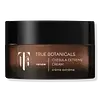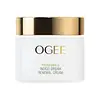What's inside
What's inside
 Key Ingredients
Key Ingredients

 Benefits
Benefits

 Concerns
Concerns

 Ingredients Side-by-side
Ingredients Side-by-side

Camellia Sinensis Leaf Extract
AntimicrobialAloe Barbadensis Leaf Juice
Skin ConditioningGlycerin
HumectantHydrogenated Vegetable Oil
EmollientMangifera Indica Seed Butter
Skin ConditioningHydrogenated Ethylhexyl Olivate
EmollientCetearyl Olivate
Sorbitan Olivate
EmulsifyingSilybum Marianum Ethyl Ester
Skin ConditioningTerminalia Chebula Fruit Extract
Skin ConditioningSodium Hyaluronate
HumectantCalendula Officinalis Flower Extract
MaskingRosa Rubiginosa Seed Oil
EmollientRubus Idaeus Seed Oil
EmollientHippophae Rhamnoides Seed Oil
Skin ProtectingSclerocarya Birrea Seed Oil
HumectantLactobacillus/Acerola Cherry Ferment
Skin ProtectingHydrolyzed Viola Tricolor Extract
Skin ProtectingPersea Gratissima Oil
Skin ConditioningSimmondsia Chinensis Seed Oil
EmollientLecithin
EmollientCaprylic/Capric Triglyceride
MaskingCarthamus Tinctorius Flower
MaskingEclipta Prostrata Extract
Skin ConditioningMelia Azadirachta Leaf Extract
Skin ConditioningMoringa Oleifera Seed Oil
EmollientPopulus Tremuloides Bark Extract
AntiseborrhoeicJuniperus Virginiana Oil
MaskingCananga Odorata Flower Oil
MaskingCedrus Atlantica Wood Oil
PerfumingAmyris Balsamifera Bark Oil
MaskingJuniperus Mexicana Oil
MaskingLavandula Angustifolia Oil
MaskingTocopherol
AntioxidantHydrogenated Olive Oil Unsaponifiables
EmollientLeuconostoc/Radish Root Ferment Filtrate
AntimicrobialXanthan Gum
EmulsifyingSodium Phytate
Phenethyl Alcohol
MaskingEthylhexylglycerin
Skin ConditioningCitric Acid
BufferingWater
Skin ConditioningCaprylyl Glycol
Emollient1,2-Hexanediol
Skin ConditioningLimonene
PerfumingLinalool
PerfumingCamellia Sinensis Leaf Extract, Aloe Barbadensis Leaf Juice, Glycerin, Hydrogenated Vegetable Oil, Mangifera Indica Seed Butter, Hydrogenated Ethylhexyl Olivate, Cetearyl Olivate, Sorbitan Olivate, Silybum Marianum Ethyl Ester, Terminalia Chebula Fruit Extract, Sodium Hyaluronate, Calendula Officinalis Flower Extract, Rosa Rubiginosa Seed Oil, Rubus Idaeus Seed Oil, Hippophae Rhamnoides Seed Oil, Sclerocarya Birrea Seed Oil, Lactobacillus/Acerola Cherry Ferment, Hydrolyzed Viola Tricolor Extract, Persea Gratissima Oil, Simmondsia Chinensis Seed Oil, Lecithin, Caprylic/Capric Triglyceride, Carthamus Tinctorius Flower, Eclipta Prostrata Extract, Melia Azadirachta Leaf Extract, Moringa Oleifera Seed Oil, Populus Tremuloides Bark Extract, Juniperus Virginiana Oil, Cananga Odorata Flower Oil, Cedrus Atlantica Wood Oil, Amyris Balsamifera Bark Oil, Juniperus Mexicana Oil, Lavandula Angustifolia Oil, Tocopherol, Hydrogenated Olive Oil Unsaponifiables, Leuconostoc/Radish Root Ferment Filtrate, Xanthan Gum, Sodium Phytate, Phenethyl Alcohol, Ethylhexylglycerin, Citric Acid, Water, Caprylyl Glycol, 1,2-Hexanediol, Limonene, Linalool
Aloe Barbadensis Leaf Juice
Skin ConditioningSimmondsia Chinensis Seed Oil
EmollientCetearyl Alcohol
EmollientGlycerin
HumectantLauryl Laurate
Skin ConditioningWater
Skin ConditioningRicinus Communis Seed Oil
MaskingPolyglyceryl-3 Stearate
EmulsifyingAlcohol
AntimicrobialCocos Nucifera Oil
MaskingInulin
Skin ConditioningSclerotium Gum
Emulsion StabilisingVitis Vinifera Seed Oil
EmollientPhenethyl Alcohol
MaskingCopernicia Cerifera Wax
Raspberry Ketone
MaskingCeramide NP
Skin ConditioningSodium Levulinate
Skin ConditioningCitric Acid
BufferingAcmella Oleracea Extract
Skin ProtectingSodium Anisate
AntimicrobialSodium Phytate
Glyceryl Caprylate
EmollientGlyceryl Laurate
EmollientLavandula Angustifolia Oil
MaskingGenipa Americana Fruit Extract
Skin ConditioningTanacetum Annuum Flower Oil
MaskingPhytosphingosine
Skin ConditioningSodium Hyaluronate
HumectantLinalool
PerfumingAloe Barbadensis Leaf Juice, Simmondsia Chinensis Seed Oil, Cetearyl Alcohol, Glycerin, Lauryl Laurate, Water, Ricinus Communis Seed Oil, Polyglyceryl-3 Stearate, Alcohol, Cocos Nucifera Oil, Inulin, Sclerotium Gum, Vitis Vinifera Seed Oil, Phenethyl Alcohol, Copernicia Cerifera Wax, Raspberry Ketone, Ceramide NP, Sodium Levulinate, Citric Acid, Acmella Oleracea Extract, Sodium Anisate, Sodium Phytate, Glyceryl Caprylate, Glyceryl Laurate, Lavandula Angustifolia Oil, Genipa Americana Fruit Extract, Tanacetum Annuum Flower Oil, Phytosphingosine, Sodium Hyaluronate, Linalool
 Reviews
Reviews

Ingredients Explained
These ingredients are found in both products.
Ingredients higher up in an ingredient list are typically present in a larger amount.
Aloe Barbadensis Leaf Juice comes from leaves of the aloe plant. Aloe Barbadensis Leaf Juice is best known for helping to soothe sunburns. It is also anti-inflammatory, moisturizing, antiseptic, and can help heal wounds.
Aloe is packed with good stuff including Vitamins A, C, and E. These vitamins are antioxidants, which help fight free-radicals and the damage they may cause. Free-radicals are molecules that may damage your skin cells, such as pollution.
Aloe Barbadensis Leaf Juice also contains sugars. These sugars come in the form of monosaccharides and polysaccharides, folic acid, and choline. These sugars are able to help bind moisture to skin.
It also contains minerals such as calcium, 12 anthraquinones, fatty acids, amino acids, and Vitamin B12.
Learn more about Aloe Barbadensis Leaf JuiceCitric Acid is an alpha hydroxy acid (AHA) naturally found in citrus fruits like oranges, lemons, and limes.
Like other AHAs, citric acid can exfoliate skin by breaking down the bonds that hold dead skin cells together. This helps reveal smoother and brighter skin underneath.
However, this exfoliating effect only happens at high concentrations (20%) which can be hard to find in cosmetic products.
Due to this, citric acid is usually included in small amounts as a pH adjuster. This helps keep products slightly more acidic and compatible with skin's natural pH.
In skincare formulas, citric acid can:
While it can provide some skin benefits, research shows lactic acid and glycolic acid are generally more effective and less irritating exfoliants.
Most citric acid used in skincare today is made by fermenting sugars (usually from molasses). This synthetic version is identical to the natural citrus form but easier to stabilize and use in formulations.
Read more about some other popular AHA's here:
Learn more about Citric AcidGlycerin is already naturally found in your skin. It helps moisturize and protect your skin.
A study from 2016 found glycerin to be more effective as a humectant than AHAs and hyaluronic acid.
As a humectant, it helps the skin stay hydrated by pulling moisture to your skin. The low molecular weight of glycerin allows it to pull moisture into the deeper layers of your skin.
Hydrated skin improves your skin barrier; Your skin barrier helps protect against irritants and bacteria.
Glycerin has also been found to have antimicrobial and antiviral properties. Due to these properties, glycerin is often used in wound and burn treatments.
In cosmetics, glycerin is usually derived from plants such as soybean or palm. However, it can also be sourced from animals, such as tallow or animal fat.
This ingredient is organic, colorless, odorless, and non-toxic.
Glycerin is the name for this ingredient in American English. British English uses Glycerol/Glycerine.
Learn more about GlycerinLavandula Angustifolia Oil is more commonly known as lavender essential oil. It is considered a fragrancing ingredient.
Lavender imparts a famous scent. While the smell is lovely, this ingredient and may sensitize skin in topical products. This is because about 85% of the oil is made up of linalool and linalyl acetate.
When exposed to air, these two compounds become strong allergens. This ingredient exhibits cytotoxicity at low concentrations; amounts of 0.25% have been shown to damage skin cells.
A study from Japan found this ingredient caused lavender sensitivity after widespread exposure.
Lavender essential oil has some antimicrobial, antibacterial, and anti-inflammatory properties. However, the cons of this ingredient may outweight the pros.
More research is needed to confirm lavender essential oil's effects when used in aromatherapy.
Lavandula Angustifolia is known as the English Lavender and famous for creating purple fields in Provence, France.
Learn more about Lavandula Angustifolia OilLinalool is a fragrance and helps add scent to products. It's derived from common plants such as cinnamon, mint, citrus, and lavender.
Like Limonene, this ingredient oxidizes when exposed to air. Oxidized linalool can cause allergies and skin sensitivity.
This ingredient has a scent that is floral, spicy tropical, and citrus-like.
Learn more about LinaloolPhenethyl Alcohol is a colorless and aromatic alohol. It is naturally occuring in essential oils.
The scent of this ingredient is floral and often compared to rose.
Like other alcohols, this ingredient helps prevent the growth of bacteria. However, its main purpose is to impact a fragrance.
Learn more about Phenethyl AlcoholThis oil comes from the seeds of the desert shrub called Jojoba. It is more commonly known as jojoba oil, a non-comedogenic oil.
Jojoba oil does not contain fragrance and has many fatty-acids, making it a great soothing ingredient.
It also contains Vitamin E, a great moisturizing ingredient. Vitamin E is also an antioxidant and protects your skin against oxidative damage.
This ingredient humectant properties, meaning it helps draw moisture from the air. This helps keep your skin hydrated.
While jojoba has antibacterial properties, it is only able to kill some strains of bacteria.
Studies also show it helps in wound healing. In fact, Indigenous cultures have used jojoba as a moisturizer and to help treat burns for centuries.
Fun fact: Jojoba oil similar to natural human skin sebum, so it has a great effect on dry skin. It is also promising with helping to regulate sebum production.
Due to its fatty acid content, Jojoba oil may not be fungal acne safe. We recommend speaking with a professional if you have any concerns.
Learn more about Simmondsia Chinensis Seed OilSodium Hyaluronate is hyaluronic acid's salt form. It is commonly derived from the sodium salt of hyaluronic acid.
Like hyaluronic acid, it is great at holding water and acts as a humectant. This makes it a great skin hydrating ingredient.
Sodium Hyaluronate is naturally occurring in our bodies and is mostly found in eye fluid and joints.
These are some other common types of Hyaluronic Acid:
Learn more about Sodium HyaluronateSodium Phytate is the synthetic salt form of phytic acid. Phytic acid is an antioxidant and can be found in plant seeds.
Sodium Phytate is a chelating agent. Chelating agents help prevent metals from binding to water. This helps stabilize the ingredients and the product.
Water. It's the most common cosmetic ingredient of all. You'll usually see it at the top of ingredient lists, meaning that it makes up the largest part of the product.
So why is it so popular? Water most often acts as a solvent - this means that it helps dissolve other ingredients into the formulation.
You'll also recognize water as that liquid we all need to stay alive. If you see this, drink a glass of water. Stay hydrated!
Learn more about Water